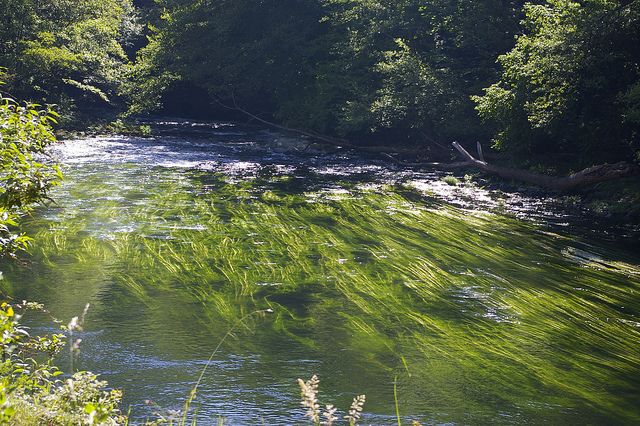 Evolution & Behaviour
Evolution & Behaviour
Symbiogenesis: how algae and bacteria shaped new genes together

Genes are an essential component of every living being. They are encoded in the DNA, and contain the information needed to produce a fully-functional organism. Deciphering the origin of new genes in organisms is important to understand how living beings adapted to their environment. Genes can emerge through numerous and diverse mechanisms. For example, new genes in plants and animals are mostly formed by recycling those already present in their own DNA while bacteria often acquire new genes by stealing them from other bacteria living in their environment. Symbiosis, the close association between unlike organisms, can also have an impact on the way genes are formed and this is what our research showed in algae.
Unlike animals which obtain energy from food, algae use light thanks to a process called photosynthesis. Photosynthesis is not an invention of algae, some bacteria have used it for billions of years. Algae just stole it roughly one billion years ago when their ancestor engulfed and domesticated a photosynthetic bacterium in its cell. The captured bacterium has been completely integrated by the algae host, which resulted in a new cellular compartment in algal cells, called the plastid, where the photosynthesis takes place. Some DNA of this captured bacterium is still present within the plastids, but most of its genes have simply been lost during the transformation process. However, a significant number of bacterial genes has also been transferred to the DNA of the algal cell. Algal cells thus carry a mosaic DNA in their nucleus, since genes from two symbionts, the host lineage and from the captured photosynthetic bacterium, co-localize.
As said previously, a common way to create new genes in algae is by recycling existing genes present in their DNA. Sometimes this process involves the combination of two different genes which are pasted together, producing mosaic genes. In algae, these mosaic genes could be very unusual, because they could form through the combination of genes from the algae and those stolen from the photosynthetic bacterium. Such genes have been called symbiogenetic genes (S-genes) because of their symbiotic origins. We looked in detail for S-genes in algae in order to know whether such genes existed and what functions they conferred to the algae.
We disentangled the history of genes in the species of algae in order to detect the origin of each part of genes and we detected 67 S-genes among the 17,000 genes investigated. Importantly, the products of S-genes (the proteins) have very specialized functions in the cell. They mostly work within the plastid, suggesting that most of these novel genes are involved in getting the new energetic central to work. Indeed, many S-genes are involved directly and indirectly in photosynthesis. They are involved in the detoxification of the algal cell but also in phototaxis (i.e. the ability of organisms or cells to move directionally in response to a light stimulus), which is essential for the algae to orient themselves most efficiently to receive light. Of note, some S-genes seem ancient because they are present in a broad diversity of algae (and even land plants that derived from these algae) and thus they may have contributed to the successful establishment of the photosynthetic bacterium during the first steps of the evolution of algae.
The discovery of this new class of genes (i.e. the S-genes) complexifies the knowledge that we have about gene creation but also helps to understand how the first plants faced the challenges of being photosynthetic. In a broader perspective, S-genes extend the concept of mosaicism in algae to the subgenic level (even their genes are mosaic, having different origins). Since the number of proposed mosaic organisms (i.e. of organisms with compartments and genes acquired from different sources) keeps increasing, it is likely that other S-genes will be discovered in other mosaic organisms.
Original Article:
Méheust R, Zelzion E, Bhattacharya D, Lopez P, Bapteste E. Protein networks identify novel symbiogenetic genes resulting from plastid endosymbiosis. Proceedings of the National Academy of Sciences. 2016;113(13):3579-3584. doi:10.1073/pnas.1517551113.Edited by:
Dr. Carlos Javier Rivera-Rivera , Managing Editor
We thought you might like
How humans gave acne to the grapevine
Feb 28, 2015 in Evolution & Behaviour | 3.5 min read by Carlos J. Rivera-RiveraTara Oceans Expedition sequences the ocean
Nov 24, 2015 in Earth & Space | 4 min read by Chris BowlerLiving without mitochondria: the downfall of one textbook truth
Oct 3, 2016 in Evolution & Behaviour | 3.5 min read by Lukáš NovákAmoebas trap bacteria using nets of DNA: the same mechanism as human immune cells
Jan 27, 2017 in Evolution & Behaviour | 3.5 min read by Lukáš NovákMore from Evolution & Behaviour
Cicada emergence alters forest food webs
Jan 31, 2025 in Evolution & Behaviour | 3.5 min read by Martha Weiss , John LillSize does not matter: direct estimations of mutation rates in baleen whales
Jan 29, 2025 in Evolution & Behaviour | 4 min read by Marcos Suárez-MenéndezThe Claws and the Spear: New Evidence of Neanderthal-Cave Lion Interactions
Jan 22, 2025 in Evolution & Behaviour | 3.5 min read by Gabriele RussoA deep-sea spa: the key to the pearl octopus’ success
Jan 20, 2025 in Evolution & Behaviour | 3.5 min read by Jim BarryFeisty fish and birds with attitude: Why does evolution not lead to identical individuals?
Aug 31, 2024 in Evolution & Behaviour | 3 min read by Lukas Eigentler , Klaus Reinhold , David KikuchiEditor's picks
Trending now
Popular topics


